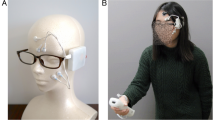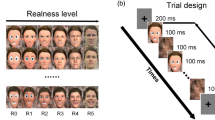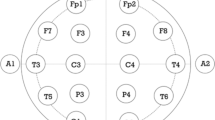Abstract
In recent years, technologies such as Kinect and Emotiv, combined with predetermined stimuli, have been widely used to perform studies in different fields such as neuromarketing, rehabilitation, medicine, among others. However, how facial and neurological activation parameters can be related has been little explored. This research aims to develop a way to synchronize data acquisition on both devices and find possible relationships between the data produced by facial tracking using the Kinect and the encephalographic signals obtained from the Emotiv. For this, an experimental design has been built with a population of 15 test subjects including both genders, who were exposed to a predetermined routine of images, which have been demonstrated and used by different neuroscience research centers since they can induce in humans emotions such as happiness, sadness, disgust or fear. Measurements were carried out in a controlled space, in total calm, away from any noise or interference that may affect data collection. Within the obtained results, it was identified some possible relationships between facial and encephalographic signals, as well as a dependent activation of the brain’s areas with the stimuli presented, in both the time and frequency domain.
Access this chapter
Tax calculation will be finalised at checkout
Purchases are for personal use only
Similar content being viewed by others
References
Lele, P.P., Sinclair, D.C., Weddell, G.: The reaction time to touch. J. Physiol. 123, 187–203 (1954). https://doi.org/10.1113/jphysiol.1954.sp005042
Puntkattalee, M.J., Whitmire, C.J., Macklin, A.S., Stanley, G.B., Ting, L.H.: Directional acuity of whole-body perturbations during standing balance. Gait Posture 48, 77–82 (2016). https://doi.org/10.1016/j.gaitpost.2016.04.008
González San José, M.L.: Metodología del análisis sensorial. In: Curso de Verano Viticultura y Enología en la D.O., pp. 85–96 (2008)
Llinás, R.R.: El cerebro y el mito del yo: El papel de las neuronas en el pensamiento y el comportamientos humanos (2003)
Palmero, F., Guerrero, C., Gómez, C., Carpi, A.: Certezas y controversias en el estudio de la emoción. REME 9, 1–25 (2006)
Solís, F.O., Dichy, R.C., Parra, G.C., García, A.E.V., García, N.A.: Valencia, activación, dominancia y contenido moral, ante est{\’\i}mulos visuales con contenido emocional y moral: un estudio en población mexicana. Rev. española Neuropsicol. 5, 213–225 (2003)
Chen, A.: Razones para prohibir el reconocimiento de emociones cuanto antes (2020)
Ekman, P.: Basic emotions. In: Handbook of Cognition and Emotion, no. 98, p. 16 (1999)
Barrett, L.F., Adolphs, R., Marsella, S., Martinez, A.M., Pollak, S.D.: Emotional expressions reconsidered: challenges to inferring emotion from human facial movements. Psychol. Sci. Public Interest 20, 1–68 (2019). https://doi.org/10.1177/1529100619832930
Regader, B.: Estudio demuestra que las emociones básicas son cuatro, y no seis como se creía (2018)
Zhang, Z.: Microsoft kinect sensor and its effect. IEEE Multimedia 19, 4–10 (2012). https://doi.org/10.1109/MMUL.2012.24
Wu, H.-H., Bainbridge-Smith, A.: Advantages of using a Kinect Camera in various applications. University of Canterbury (2011)
Cloyd, T.D., Pitt, J.C., Fuhrman, E.R., Laberge, A.F., Cloyd, T.D.: (r) Evolution in Brain - Computer Interface Technologies for Play: (non) Users in Mind (r) Evolution in Brain - Computer Interface Technologies for Play: (non) Users in Mind (2013)
Asociación Médica Mundial: Declaración de Helsinki: Principios éticos para las investigaciones médicas en seres humanos (1964)
Minsalud, R.N.: 8430 DE 1993. Por la cual se Establ. las normas científicas, técnicas y Adm. para la Investig. en salud. Minist. Salud Colomb., pp. 1–19 (1993)
Brenner, E., Smeets, J.B.J.: Chapter 4 - Accumulating visual information for action. In: Howard, C.J. (ed.) Temporal Sampling and Representation Updating, pp. 75–95. Elsevier (2017). https://doi.org/10.1016/bs.pbr.2017.07.007
Microsoft: Microsoft Kinect V2
Bauer, S., Wasza, J., Haase, S., Marosi, N., Hornegger, J.: Multi-modal surface registration for markerless initial patient setup in radiation therapy using microsoft’s Kinect sensor. In: 2011 IEEE International Conference on Computer Vision Workshops (ICCV Workshops), pp. 1175–1181 (2011). https://doi.org/10.1109/ICCVW.2011.6130383
Terven, J.R.: Kinect 2 interface for Matlab (2017)
Regidor Serrano, M.: Reconocimiento de expresiones con Kinect (2015)
Hamm, J., Kohler, C.G., Gur, R.C., Verma, R.: Automated facial action coding system for dynamic analysis of facial expressions in neuropsychiatric disorders. J. Neurosci. Methods 200, 237–256 (2011)
Pessoa, L.: On the relationship between emotion and cognition. Nat. Rev. Neurosci. 9, 148–158 (2008)
Acknowledgments
Authors want to thank to the Universidad Antonio Nariño for all the financial support to this work under the project number 2018218.
Author information
Authors and Affiliations
Corresponding author
Editor information
Editors and Affiliations
Rights and permissions
Copyright information
© 2020 Springer Nature Switzerland AG
About this paper
Cite this paper
Plazas-Molano, A.C., Duarte-González, M.E., Blanco-Díaz, C.F., Jaramillo-Isaza, S. (2020). Exploring the Facial and Neurological Activation Due to Predetermined Visual Stimulus Using Kinect and Emotiv Sensors. In: Figueroa-García, J.C., Garay-Rairán, F.S., Hernández-Pérez, G.J., Díaz-Gutierrez, Y. (eds) Applied Computer Sciences in Engineering. WEA 2020. Communications in Computer and Information Science, vol 1274. Springer, Cham. https://doi.org/10.1007/978-3-030-61834-6_23
Download citation
DOI: https://doi.org/10.1007/978-3-030-61834-6_23
Published:
Publisher Name: Springer, Cham
Print ISBN: 978-3-030-61833-9
Online ISBN: 978-3-030-61834-6
eBook Packages: Computer ScienceComputer Science (R0)




